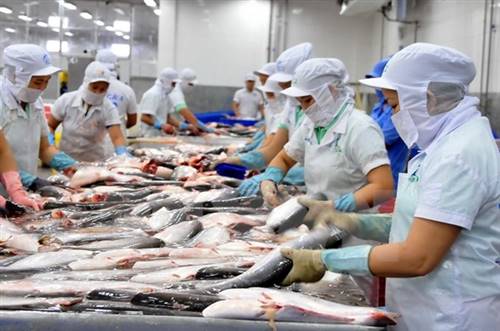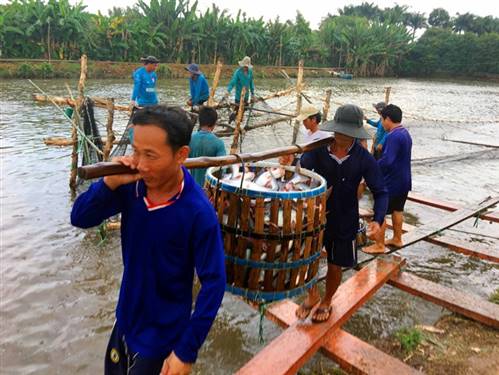Pangasius prices spike on shortage, which could last until 2019
Posted on 8/4/2018 12:00:00 AM by
Mekong Seafood Connection told Undercurrent prices had risen to $2.80 per kilogram for 100% net weight, standard glaze freight-on-board from Ho Chi Minh City.
However, two other sources – executives with Vietnamese packers, wishing to remain anonymous – said prices were roughly $3.20/kg.
“I expected prices might move a nudge as we approached Chinese New Year, but we're seeing ex-farm gate prices hitting VND 30,000,” said one executive.
“The premium product to Europe is at $4/kg now, so yes, $3.20/kg for standard is not unlikely.”
A source with a major EU importer confirmed this.
“Those prices are right. There is a big pressure on the market, less fish, high demand, high prices. Some of the factories even closed their doors for a few days per week due to a lack of raw material,” he said.
One further source, with a trading house, said he too saw prices over $3.00/kg; “[product] on my hands is $3.25-$3.45/kg,” he said.
The EU importer source suggested these high prices “will for sure continue in the first quarter”, largely in line with strong Chinese demand, and other sources did not disagree.
Broodstock shortage
Early in 2017 Vietnam began to see a shortage of broodstock, which has continued and, by the sounds of it, suffered a further setback.
“Current broodstock levels are low, and you can't spawn them too many times a year,” said one of the execs with Vietnamese packers. “On top of that we've had cool weather, caused by a typhoon which came along on Dec. 25, 26.”
He added that, unusually, mortalities at hatchery ponds have been very high recently. “Usually condition are so well controlled there, major mortalities usually happen at the 20-gram stocking stage. But hatchery ponds have been seeing 40% or 50% mortality rates.”
This does not really affect the vertically-integrated players, he added.
“[Farmers] are upping stocking densities, and digging new ponds...they're trying to grow, there just aren't any 20-grammers to stock.”
The second executive with a packer added that fingerling prices now are around VND 70,000/kg, when the highest level in 2017 – when there had also been something of a shortage – had been VND 63,000/kg.
“People are expanding the fingerling production, however, the weather conditions these weeks have made the supply worse, and as we observe it normally took two years of shortage of supply before the whole farming chain could recover.”
So, not until April 2019 does this firm expect raw material availability and pricing to stabilize.
Continued price rises forecast
Each of Undercurrent's sources predicts prices will strengthen through 2018.
At present the raw material situation is such that “many factories cannot finish their pending contracts on time, since last October and up to now,” said the source at the trading firm. “That is still troublesome.”
“I'm just worried that this impact will continue to push up the price even after the Tet holiday [Feb. 16].”
They do not foresee any dip in the price due to Tet, as “the factories and major suppliers know how to control the supply to the market”.
One of the sources with the packers suggested there could be a brief lull in demand, and softening in price, around April to June, but that a rise was again expected from July or August, through to the year-end.
China shows no signs of slowing its interest in Vietnamese pangasius, with the two packers and the trader confirming it should remain a key market in 2018.
Its progression down the value chain seems to be fairly rapid; already China is developing an interest in fillets with brown meat included, white-meat-only fillets, fillet rolls, and marinated products, the two packers said.
'Europe needs to decide'
Neither of the packer sources felt the EU was set for a market revival in 2018, in those markets which were hurt by negative press coverage in 2017.
“[Statistics show] the EU market overall will drop 17.3% for January to September, (2017, compared to 2016). The UK is growing strongly at 14.1% and Belgium at 7.7%.”
“If there is no bad news, or lessening of pangasius' image, the market should recover in some markets who are more open, like the UK. But the traditional markets like Spain, Italy, France and so on, I am not that sure.”
The two packers confirmed only the UK really seems promising in Europe.
“Europe needs to figure out what it wants from fish in general,” said one of the executives. “Major retail chains have a choice now; with Alaska pollock, Russia pollock, cod, hoki, they have some options.”
These two packers noted Mexico and Brazil – alongside the major US and Chinese markets – were interesting. Both are becoming quite sophisticated, with a taste for the type of premium products the vertically-integrated firms can produce, they said.
'More of the same' for US
Finally, the US looks to experience more of the same in terms of pangasius imports.
Don Kelley, procurement manager with US importer Western Edge Seafood, told Undercurrent he was seeing prices of $2.20-$2.40 per pound, depending on moisture.
He expects a stability at this level, with supply tight and demand from China great.
“Prices are high, but stable,” added the Vietnam-based packer. “Under the 100% inspection rules there's some uncertainty – I heard Sysco wasn't doing any development with pangasius until things settle down, but US Foods is interested still.”
There remains an element of breath held over the matter of the US Department of Agriculture's equivalency rating procedure.
Both Vietnam as a country, and individual companies hoping to sell to the US, must gain the equivalency in order to do so.
“I've not heard of any company-level talks [with the USDA Food Safety and Inspection Service] yet – it seems to be stuck at country-level still,” said the executive with a Vietnamese packer.
“I heard Hanoi has completed the second-stage [processes], and it's in FSIS hands now. Next is stage three, then they'll pick a representative few companies to inspect and certify.”
Vietnam files complaint with WTO
It recently emerged that Vietnam has filed a complaint with the World Trade Organization (WTO) over the US' anti-dumping duties on pangasius.
In September 2017 -- when Undercurrent broke the news that the US Department of Commerce planned to hit each Vietnamese pangasius firm with the same blanket anti-dumping tariff, from March 2018 -- one source had suggested Vietnam may take the issue to the WTO.
“The normal process for these tariffs is that in September or October we hear the DoC's preliminary findings for the period of review, the we're allowed to state briefs and our case for why maybe that's incorrect,” this source told Undercurrent in January 2018.
“Then the DoC aims to make a final determination in March. But so far we haven't even been given a date to brief them yet. I'm hearing maybe it might be arranged by the end of January, but currently we've not even had a meeting lined up with the DoC. We've invited them to Vietnam – nothing. I think they're very busy.”
/PANGASIUS%20CUBES-%20WELL%20TRIMMED%20-1.jpeg?mode=crop&anchor=auto&scale=both&scache=true)
/catralamdau-2.jpg?mode=crop&anchor=auto&scale=both&scache=true)
/Pangasius%20Fillet%20Untrimmed-5.jpg?mode=crop&anchor=auto&scale=both&scache=true)
/carophi-1.jpg?mode=crop&anchor=auto&scale=both&scache=true)
/PANGASIUS%20STEAK%20-4.jpeg?mode=crop&anchor=auto&scale=both&scache=true)
/Pangasius%20Butterfly-%20Headless).jpg?mode=crop&anchor=auto&scale=both&scache=true)



